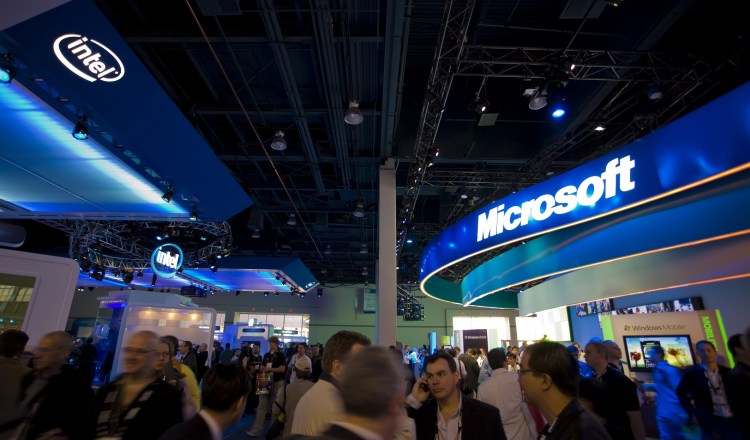While virtual reality has been high in the hype cycle for a couple of years now, its market impact has been relatively modest. High visibility VR headset products like Oculus and Microsoft’s HoloLens created a lot of smoke but relatively little fire. The high prices, lack of standards, and lack of compelling apps (other than a limited number of games) have hampered growth, particularly in business uses. But that may be about to change.
At the recent Intel Developer’s Forum in San Francisco, Intel’s CEO Brian Krzanich demonstrated his company’s standalone VR headset prototype, called Project Alloy. Using a number of Intel technologies, like RealSense 3D imaging and Intel Core processors with graphics and signal processing capability, it allows users to see objects around them in the physical world coupled with virtual images that can be manipulated through hand gestures. But the biggest news is that Intel won’t be making the devices itself. It proposes to promote a totally open “reference design” to make Project Alloy available to any manufacturer wanting to make its own product. Importantly, Microsoft was also present at IDF to announce its intent to bring its VR platform for Windows 10, called Windows Holographic, to the mainstream by including it in future (2017) versions of Windows and by working with Intel to make Project Alloy compatible. [Full disclosure: Intel is a client of mine.]
In my opinion, Intel and Microsoft have announced a collaboration that will finally see VR achieve a level of mainstream acceptance. Much like in the early days of the PC when “Wintel” initiated a rush by manufacturers to build out a total device ecosystem, the leadership of Intel in hardware (Project Alloy open sourced) and of Microsoft in software (Windows standardized Holographic extensions) will propel this area beyond the proprietary nature of early vendors into a world of compatible and highly competitive devices.
Standards bring increased investment and deployment and will ultimately make products available to users at lower cost and with better features/functions while creating a critical mass around which a full ecosystem can ultimately explode. And it will expand the market beyond gaming to include a myriad of business-oriented and consumer-friendly solutions.
There are some drawbacks to Project Alloy. Some vendors may object to being totally dependent on Intel technology like RealSense, or not having leeway to use other processors. But I don’t expect this to be a major obstacle to adoption, although it will put pressure on competing hardware component suppliers, which is obviously part of Intel’s plan to capture market share. It’s likely that Project Alloy will create enough leeway in component selection that it will ultimately benefit everyone. And complaints that Microsoft wants to control VR with Windows will also likely not result in major backlash from alternative OS aficionados.
Although it didn’t see much coverage in the media, I expect this announcement will energize the world of VR over the next 2-3 years and create a burgeoning marketplace. This will force early device makers (e.g., Oculus, Epson) to pivot over the next 1-2 years, as proprietary designs will capture a limited market relegated to specialty solutions. Microsoft may even ultimately abandon its own HoloLens efforts (built with older Intel Atom CherryTrail chips), although that is unlikely for the next 1-2 years, as rumors of a new version of the device are now circulating.
I expect to see at least 10-15 designs of Project Alloy derived VR devices in market within the next year — and more the following year as apps catch up to the hardware availability. And momentum from the Intel/Windows collaboration will likely overwhelm (in sheer volume) competing product ecosystems, including what Apple may decide to create.
Putting the “Wintel” weight behind VR will have a major positive impact on the market for PC-based VR. But it will have little effect in the short term on many of the efforts stemming from smartphone-powered VR systems (e.g., Samsung Gear, Google Cardboard). Since they are Android based, and use competing non-Intel chips (ARM-based processors from Qualcomm, Samsung, Mediatek, etc.), this part of the market will develop separately. But what happens in the PC-enabled VR market will ultimately have significant influence on the smartphone device side as well. Compelling apps will have to be built across platforms to engage end users. But many will begin in the higher performance realm of the PC before being ported to mobile devices. The challenge will be having different drivers, APIs, and underlying VR standards that may cause the two competing platforms to remain incompatible for several years.
So what’s the bottom line? Intel Project Alloy and Microsoft’s Windows Holographic extensions may finally generate enough momentum to create a VR market that can scale large enough to sustain itself. It’s likely that within the next two years, we will see an aggressive growth spurt building out a hardware/software ecosystem that will make VR affordable and achieve mass market penetrations, both for consumer and business users. VR may finally catch up to the hype!
Jack Gold is founder and principal analyst at J.Gold Associates, an IT analyst firm based in Northborough, MA., providing research and analysis of the many aspects of business and consumer computing, and emerging technologies. Follow him on Twitter @jckgld.


